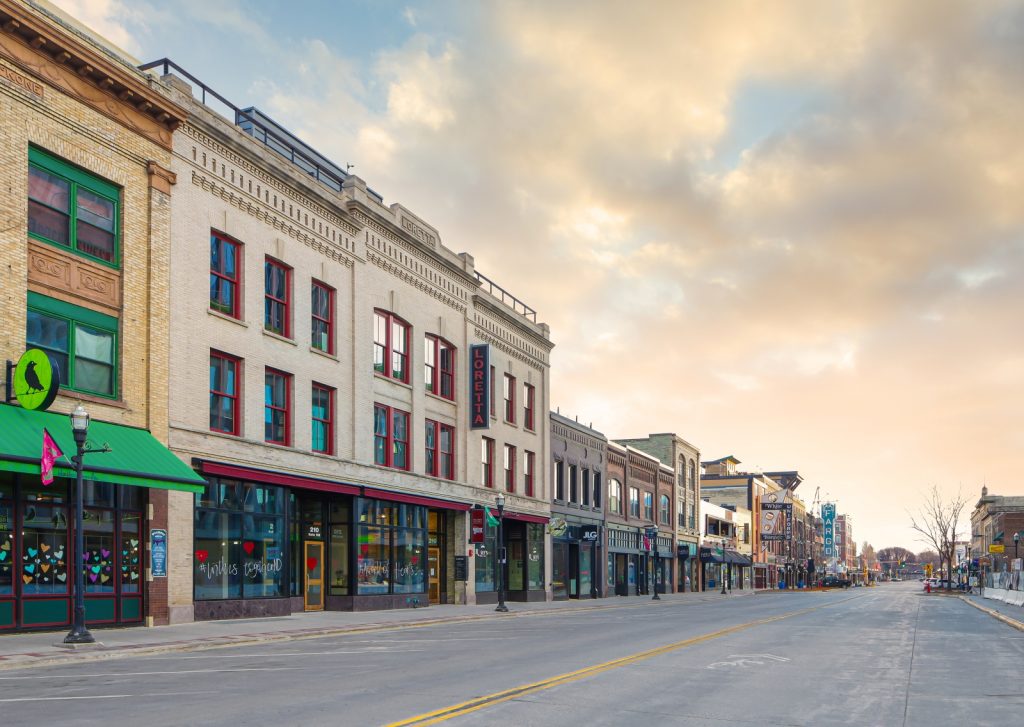
| By Mari Hall |
It feels like just yesterday that the 2021 Main Street ND Summit wrapped up in West Fargo, and our heads are still spinning with all of the inspirational energy that came from each speaker. Now that we’ve had some time to reflect on everything we learned (and rewatch some of the keynotes), we’d like to share some of our favorite takeaways.
Speaker after speaker emphasized one core idea: Build where there’s already infrastructure.
When developers come to a property in an area with existing infrastructure, whether it is to build something new or renovate what is already there, they’re doing a service to the communities those projects call home. While city growth is an admirable goal, the costs of new infrastructure and its required maintenance are typically passed on to the taxpayers who reside there rather than the developer. Although suburban communities are essential to places like Fargo, suburban sprawl and the infrastructure it requires can constitute a heavy burden on taxpayers.
“We’re not trying to criticize the past, we’re trying to reinvent the future. But we have to look at what we’ve done and say, ‘Can we use it better?’” said Gov. Doug Burgum during his opening address.
So how do we make the most of the infrastructure we have? Urban development that incorporates mixed-use projects is key to capitalizing on existing infrastructure, an idea that is part and parcel of the Main Street initiative.
“It’s just like designing a plane,” said Tristan Cleveland, healthy communities researcher for Happy City. “Everything you design on a plane has to support it flying. Everything you design on a main street has to support it being a main street.”
Joe Minicozzi, the principal of land value economics agency Urban3, emphasized reevaluating a building’s economic productivity based on a per-acre system.
“Your buildings are like a crop in your city,” said Minicozzi. Each building contributes to an acre’s tax revenue, job count, and resident capacity. He used the taxable value per acre of 13th Ave Walmart in Fargo as an anchor point, coming in at $534,342. Comparatively, the mixed-use development at 300 Broadway N has a valuation of almost $21 million per acre based on the footprint of the building. The Radisson Blu hotel in downtown Fargo came in as Cass County’s highest value per acre property at over $77 million.
“Look at the data,” said Minicozzi. “Which one is giving you more wealth?”
Minicozzi challenged the summit attendees to think critically about the value that every building and piece of infrastructure was bringing to their cities and to remember that design and density drive valuation, not necessarily what kind of businesses occupy a space or how new a building is. Even an old, seemingly blighted building or block could be generating a surprising amount of wealth for your community.
Chuck Marohn, author of Strong Towns and land-use planning expert, built on that challenge, asking, “If we wanted to go out today and increase the wealth on that old and blighted block, what would you do?”
Throughout the summit, emphasis was also placed on pursuing designs that created stepping stones for economic success, such as missing-middle housing or microshops.
“We need to lower the bar of entry and let more people participate in building the city,” said Marohn.
When cities and developers partner to intentionally design spaces that are more affordable, it offers a greater chance for entrepreneurs, start-ups, and first-time homebuyers to succeed on a small scale before graduating to a larger retail space, office, or home that comes with greater financial hurdles.
Marohn heralded Muskegon, Michigan, as an example of how taking a leap to support entrepreneurial citizens can play a critical part in developing a vibrant community and successful economy. Muskegon created a series of small-scale commercial spaces ranging from 90 to 150 square feet and placed them on a vacant plot of land, leasing them out to entrepreneurs and small business owners at a vastly more affordable rate than a larger, more established commercial space. The end result? A tourist destination and more locally owned businesses that were able to upgrade as they grew to brick-and-mortar commercial spaces.
“This is an entrepreneur incubator,” said Marohn, “and it’s also great urban design.”
At the end of the day, a city’s value doesn’t mean much if it isn’t a place that people want to live in, and this was emphasized over and over again during the 2021 Main Street ND Summit.
“It doesn’t matter what all of us want,” said Burgum, referencing those in attendance. “It matters what the next generation wants.”
Marohn issued the same decree, saying, “I think the question that we need to ask here today is not how do we get the next middle-class family here today.” Instead, he said, we should be focusing on what would get an NDSU college student stay in Fargo following graduation.
“More and more, the economy we have is one where young, talented people move to the cities where they want to live, and the jobs come to them,” said Cleveland. He offered a wealth of insights into just how a city can go about creating an alluring place to live, work, and play for the next generations. Among them were walkable streets with a plethora of elements to keep the human eye busy, places that feel intended for people with features like places to sit, doors to walk through, and windows to look in.
“If we want to design communities that succeed economically, that keep and attract talent, we need to design streets like this,” Cleveland said.
To learn more about the 2021 Main Street ND Summit or to watch the sessions for free, click here. The featured image is by Dan Francis.